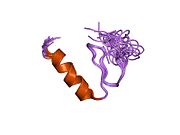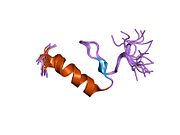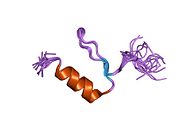KLF3
| KLF3 | |||
|---|---|---|---|
Gene ontology | |||
| Molecular function | |||
| Cellular component | |||
| Biological process | |||
| Sources:Amigo / QuickGO | |||
Ensembl | |||||||||
|---|---|---|---|---|---|---|---|---|---|
| UniProt | |||||||||
| RefSeq (mRNA) | |||||||||
| RefSeq (protein) | |||||||||
| Location (UCSC) | Chr 4: 38.66 – 38.7 Mb | Chr 5: 64.96 – 64.99 Mb | |||||||
| PubMed search | [3] | [4] | |||||||
| View/Edit Human | View/Edit Mouse |
Krüppel-like factor 3 is a protein that in humans is encoded by the KLF3 gene.
Structure
KLF3, originally termed Basic Krüppel-like Factor (BKLF), was the third member of the
C-termini. Since their DNA-binding domains are highly conserved within the family, all KLF proteins recognize CACCC or CGCCC boxes of the general form NCR CRC CCN, (where N is any base and R is a purine
).
Function
While the C-termini are similar in different KLFs, the
N-termini vary and accordingly different KLFs can either activate or repress transcription or both. KLF3 appears to function predominantly as a repressor of transcription. It turns genes off. It does this by recruiting the C-terminal Binding Protein co-repressors CTBP1 and CTBP2.[6][7] CtBP docks onto a short motif (residues 61-65) in the N-terminus of KLF3, of the general form Proline – Isoleucine – Aspartate – Leucine – Serine (the PIDLS motif).[6][7] CtBP in turn recruits histone modifying enzymes to alter chromatin
and repress gene expression.
KLF3 is expressed highly in the red blood cell or erythroid lineage. Here it is driven by another KLF, Erythroid KLF or
knockout mice reveal a mild anemia in the absence of functional KLF3 and the de-repression of several target genes that contain CACCC boxes in their regulatory regions.[8] Many of these genes are activated by KLF1, hence it appears that KLF3 operates in a negative feedback loop to balance the activating potential of KLF1. KLF3 also regulates another repressive KLF, KLF8.[9] Thus KLF1, KLF3 and KLF8 operate in a tight regulatory network. KLF3 and KLF8 may have redundant functions, as mice lacking both KLF3 and KLF8 show defects that are more severe than in either single knockout. They die in utero around day 14 of gestation.[10]
As well as being expressed in erythroid cells, KLF3 is present in other cell types and analysis of the
knockout mice has revealed defects affecting adipose tissue[11] and B cells.[12] KLF3 deficient mice have less adipose tissue and indications of metabolic health that may be attributable to de-repression of the adipokine hormone gene adipolin.[13] The role of KLF3 in B lymphocytes is complex but it appears to operate in a network with KLF2 and KLF4 to influence the switch between spleen marginal zone and follicular B cells.[14]
Interactions
KLF3 has been shown to
interact
with:
References
- ^ a b c GRCh38: Ensembl release 89: ENSG00000109787 - Ensembl, May 2017
- ^ a b c GRCm38: Ensembl release 89: ENSMUSG00000029178 - Ensembl, May 2017
- ^ "Human PubMed Reference:". National Center for Biotechnology Information, U.S. National Library of Medicine.
- ^ "Mouse PubMed Reference:". National Center for Biotechnology Information, U.S. National Library of Medicine.
- PMID 8657145.
- ^ PMID 12556451.
- ^ PMID 9724649.
- PMID 22711990.
- PMID 18687676.
- PMID 23716600.
- PMID 18391014.
- PMID 22003205.
- PMID 23633521.
- S2CID 38842040.
Further reading
- Turner J, Crossley M (2000). "Basic Krüppel-like factor functions within a network of interacting haematopoietic transcription factors". Int. J. Biochem. Cell Biol. 31 (10): 1169–74. PMID 10582345.
- Wang MJ, Qu XH, Wang LS, Zhai Y, Wu SL, He FC (2003). "cDNA cloning, subcellular localization and tissue expression of a new human Krüppel-like transcription factor: human basic Krüppel-like factor (hBKLF)". Yi Chuan Xue Bao. 30 (1): 1–9. PMID 12812068.
- Perdomo J, Verger A, Turner J, Crossley M (2005). "Role for SUMO modification in facilitating transcriptional repression by BKLF". Mol. Cell. Biol. 25 (4): 1549–59. PMID 15684403.
- Kimura K, Wakamatsu A, Suzuki Y, Ota T, Nishikawa T, Yamashita R, Yamamoto J, Sekine M, Tsuritani K, Wakaguri H, Ishii S, Sugiyama T, Saito K, Isono Y, Irie R, Kushida N, Yoneyama T, Otsuka R, Kanda K, Yokoi T, Kondo H, Wagatsuma M, Murakawa K, Ishida S, Ishibashi T, Takahashi-Fujii A, Tanase T, Nagai K, Kikuchi H, Nakai K, Isogai T, Sugano S (2006). "Diversification of transcriptional modulation: large-scale identification and characterization of putative alternative promoters of human genes". Genome Res. 16 (1): 55–65. PMID 16344560.
- Olsen JV, Blagoev B, Gnad F, Macek B, Kumar C, Mortensen P, Mann M (2006). "Global, in vivo, and site-specific phosphorylation dynamics in signaling networks". Cell. 127 (3): 635–48. S2CID 7827573.
External links
- KLF3 protein, human at the U.S. National Library of Medicine Medical Subject Headings (MeSH)



